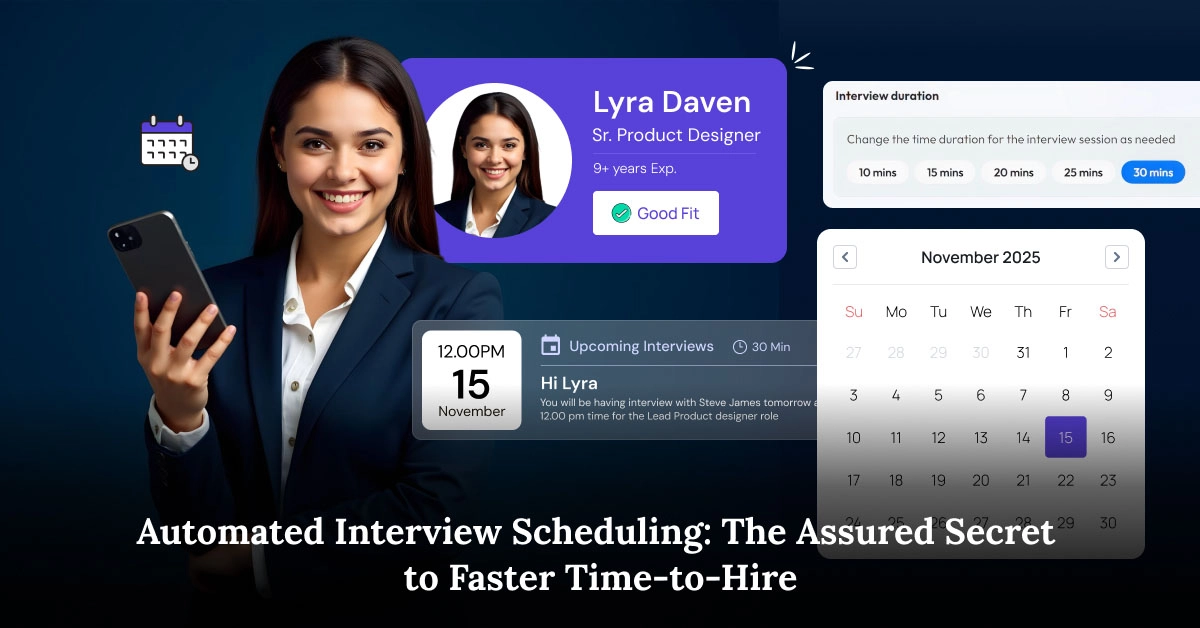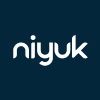Automated Interview Scheduling: The Assured Secret to Faster Time-to-Hire

Fast and efficient hiring with quality candidates is a need of the hour in today’s time. This helps in right moment engagement, prompt interview schedules and timely updates to keep them informed. The right solution is – Automated interview scheduling.
Upon successful shortlisting of a candidate, the real task of suitable time for interview schedule appears up for the HR desk. Both sides time suitability is the main factor to consider. Calendar and time availability must be checked for both sides. More emails for this task can be written towards the final confirmation.
Sometimes, one side wishes to change the fixed appointment at the last moment. This leads to a major delay in this task.
These delays are frustrating for both ends. According to Cronofy’s Candidate Expectations Report (2024), 42% of candidates report dropping out of the hiring process due to long scheduling. Slow scheduling cost time as well as best talent to lose forever.
This calls for a more simplified and automated interview scheduling process to help you to drop off time-to-hire, free up many productivity hours, and give candidates a personalized, modern experience.
Interview scheduling automation allows interview management more efficiently without any active human coordination. Availability Time clock can be set for the selection of the candidates as per their convenience. The system updates calendar automatically, manages time zone differences, and sends reminders, making sure about timely interviews to happen. This not only saves many administrative works but also minimises errors like double-bookings, and gives candidates a seamless, more predictable hiring experience with automated recruitment.
Time-to-Hire Concept and It’s Importance
Time-to-hire calculates the days between when a candidate enters in your recruitment process till, they accept an offer. By simplifying recruitment and lowering hiring delays, organisations may make candidates engaged and drop-down recruitment costs significantly.
It’s tough to differ in time-to-hire and time-to-fill:
- Time-to-hire: It is the measured time limit from a candidate arrives in your recruitment drive channel and when he gets an offer in actual.
- Time-to-fill: Sums up the total duration from the job posting is done until it’s filled up, with both sourcing and hiring.
A long hiring process gives more damage than anticipations.
Finding ways to drop down time-to-hire is tough because:
- It improves the risk of losing top talent to close competitors
- It lowers down productivity rate and affects revenue
- It raises your cost per hire (currently averaging about US$4,683 in 2025 globally)
According to a 2025 survey by HR Lineup, the worldwide average time-to-hire is 36 days, and various employers report talent shortages, making hiring speed more is becoming critical than ever.
Stressed of Coordination Delays?
Implement Automated Hiring and speed up your time-to-hire.
Interview Delays Affects Hiring Results
At actual, scheduling looks like a tiny task. But it forms candidates’ perception of your company and indicates the smoothness of the hiring journey.
There are Problems with Traditional Scheduling:
1. To-and-fro Emails
Every interview request normally propels a chain of emails between you, your hiring manager and the candidate. This slower the process and spoils measurable time which could be useful in evaluating talent.
2. Scheduling Conflicts
Upon the availability of candidates, hiring managers often tight calendars. This forces for restarting the cycle, causing inefficiencies and delays.
Poor Candidate
Experience: Candidates normally receive many follow-up emails or to deal with last-minute rescheduling. They must wait for a long time for the final confirmation. This uncertainty makes stressful situation and replies poorly on your employer brand.
3. Time-bound Human Coordination
Other than working on certain hiring tasks like talent evaluation or relations-building, you as a HR/recruitment person, become only a schedule generator. Almost 35% of the time is wastage in the last year only in humanised scheduling task.
4. High Risk of Errors
With number of human steps, the double-booking issue, mismatched time zone, or improper invites increase. These errors lead to wastage of time and can damage candidate trust.
5. Global Hiring Becomes Messy
For remote or international candidates, time zone conversions and availability matching make additional challenge, making manual scheduling nearly impossible to measure.
These Problems Affect Directly on Hiring End-Results:
1. Candidate Drop-Off
Candidates don’t prefer for waiting. If you’re working slowly in the process, you may lose them.
2. Employer Image
Candidates mostly relate slow interview process with bad organizational culture. Their enthusiasm for the role may get down, even though they are in the process.
3. Recruiter Work Volume
Instead of talent engagement, recruiters spend hours in administrative hurdles. This lowers their ability to fill pipelines smoothly.
4. High Risk of Errors
With so many manual steps involved, the double-bookings, missed time zone adjustments, or wrong invites may rise. These mistakes spoils time and may damage candidate trust.
5. Global Hiring Becomes Tedious
For remote or international candidates, time zone conversions and availability matching create additional complexity, making manual scheduling nearly impossible to update or improve.
These Problems have a Direct Impact on Hiring Outcomes:
1. Candidate Drop-Off
Candidates don’t like to wait for interviews. If your interview process is very slow, you are going to lose them.
2. Employer Reputation
Candidates mainly resonate slow scheduling with lowered level organizational culture. Even if they stay in the process, their interest for the role may drop.
3. Recruiter Workload
Without getting engaged with the talent, recruiters spend many hours in administrative work. This reduces their ability to fill pipelines effectively.
In an industry where speed and efficiency matter more than ever, interview scheduling delays can quietly derail hiring success.
Upgrade your workflow with smart tech.
Leverage AI Hiring Process tools for perfect Automated Scheduling.
Statistical Facts to Note
Find here the major statistical facts we are discussing in this blog in a summarised chart below:
Metric | Value | Implication for Manual Scheduling | Source Cited (Year) |
Candidate Drop-off Rate (due to long scheduling) | 42% | Almost half of candidates are lost because the scheduling process is very slow. | Cronofy’s Candidate Expectations Report (2024) |
Recruiter Time Spent on Scheduling | 35% | Recruiters spend more than one-third of their work week purely on administrative scheduling tasks, rather than talent evaluation work. | Unspecified Survey (2024) |
Global Average Time-to-Hire | 36 Days | The existing average duration of the hiring process is more than one month, highlighting significant room for acceleration / speed. | HR Lineup Survey (2025) |
Average Cost Per Hire (Global) | US$4,683 | Lengthy hiring processes lead to this high cost, which automation aims to reduce. | Unspecified Global Average (2025) |
AI Automation Usage in Hiring Teams | Top 3 Tasks | Interview scheduling is one of the top 3 areas where hiring teams are actively using AI/automation tools. | Good Time’s Hiring Insights Report (2025) |
Role of Interview Scheduling Automation in Modern Recruitment

Automated interview scheduling resolves the issues of conventional scheduling loops by eliminating the manual coordination between the involved parties. Instead of limitless email communications, scheduling becomes a simplified, self-service experience. Instead of recruiters acting mediators, candidates are given a secure scheduling link syncing directly with the hiring team’s availability. The candidate can choose their desired slot fitting in their own calendar, and the interview is confirmed instantly for both sides involved. HR teams use best virtual office software which may further centralize scheduling and communication inside their recruitment workflows.
The benefit is not only for speed, but it also makes a smooth candidate experience where they feel process comfortable to use. Many hours each week that would otherwise be spent in activities such as managing calendars, especially when a bulk hiring is on the cards. As per the Good Time’s Hiring Insights Report (2025), interview scheduling is among the top 3 tasks where hiring teams leverage the AI automation.
Key Roles in Automated Interview Scheduling in Modern Recruitment
- Improves efficiency and cost reduction: Automation removes the to-and-fro emails and calls covered in manual scheduling, saving remarkable time of recruiters and dropping down administrative costs. This makes them to entrust on other important recruitment actions and could lead to rapid time-to-hire.
- Candidate experience improvement: Candidates can select interview times fitting their schedule, which is mostly their first ever real interaction with the company. Auto reminders helping in reduction of no-shows and ensure a smooth, highly professional experience from the outset.
- Uplifted/ Elevated accuracy: Automation declines manual error in scheduling, stopping issues like double bookings and missing appointments. It makes sure that all line-up interviews are perfectly booked and communicated. Think of it like having a smart personal assistant who never misses a detail.
This precision seems not extra embarrassing mix-ups where a candidate is kept waiting because 2 different managers by mistake booked the same room or time slot. By directly integrating with each one’s calendars and managing automatic time zone conversions, the system acts as a free coordinator, gaining confidence and professionalism to each candidate interaction.
This reliability mostly boosts your employer brand. When a candidate gets a crisp, error-free invitation straight away, it indicates an organized, respectful company. It removes the stress of manual checking and regular follow-ups from your recruiter’s plate, allowing them to emphasis on top talent engagement rather than correcting avoidable scheduling mistakes.
- Offers easier integration: Most automated scheduling tools hook right into calendars like Google Calendar or Outlook, so each one sees new bookings show up right away – both the candidate and the hiring team. It makes handling different time zones way less of a headache.
- Enhances communication: These kinds of Automated systems may send immediate confirmations and follow-up reminders to candidates, making sure about having all the required information and are getting ready for their interview.
- Modernizes the employer brand: By providing a self-service option for candidates, a company can appear latest, flexible, and respectful of their time, which can be a competitive advantage in grabbing top talent. This going to improve the brand image in the recruitment arena as well as from the perspectives of the aspiring candidates willing to join the brand. Modernization is the key to all great results.
Which are Tools for Automated Interview Scheduling?
1. Integration of Calendar

The base of automated scheduling is actual calendar integration. The various platforms like Calendly, Outlook, or Google Calendar are easy to connect, so the system displays the most ready- to- have availability of hiring managers. If a manager books for a client meeting or blocks another task for the given time, booked slots are automatically eliminated from the candidate-facing schedule.
So, no more worry for double-bookings or last-minute apologies. This integration assures for the accuracy and develops trust; candidates can see the available slots only.
2. Job Boards and ATS
Applicant Tracking Systems (ATS) and job boards have now become more than job postings and storing resumes duties; they have developed into full-scale recruiting hubs including automated interview scheduling.
Job boards like Monster and LinkedIn have built-in scheduling features to enable candidates for selecting the available slots immediately upon submitting their application.
ATS platforms like Workday, Greenhouse with iCIMS directly integrating with scheduling and interviewing tools, permitting you for interviews schedule without making exit from the ATS.
3. Interview Platforms with Scheduling Tools
Latest video interviewing platforms have built-in interview scheduling tools. You can configure your and team’s availability on the system’s calendar, which can automatically adjust time zones also. The candidates can easily book their required slot, making it easy to match candidate and interviewer availability in some clicks. They also get real-time calendar invites, automatic reminders, and have the ease to reschedule within the same interface. It’s also easier to automatically book appointments through telephone with Voice AI Agents.
This means not much time for coordination and more time available to spend for candidate evaluation for the best fit.
Best Practices for Implementing Recruitment Automation
To optimize your automation benefits and drop down the time-to-hire, please check out here the best practices for implementing recruitment automation.
1. Begin Small and Expand
Start by automating one or two important tasks, like CV screening or interview scheduling. Then, expand upon your team’s convenience.
2. Educate the Team for the Same
Hiring managers, recruiters must be aware of using the tools and how to utilise them within the process.
3. Select Smart Integrations
Select solutions those working well with your ATS, HRIS, and communication tools to skip duplication efforts.
4. Sustain a Human Touch
Even with the right automation, enable time for personalized outreach, certainly for high-priority candidates.
5. Check and Optimise Regularly
Track the metrics – candidate experience, time-to-hire and drop-off rates. Try the data to tune well the workflows, update screening criteria, and set automation rules.
6. Get Candidate Feedback
Ask candidates about their experience for the process. Their view can mark out where automation is supporting and where it could be overstepping.
Note that, the goal is not to replace recruiters with Automation technology, but to make them more influential. When automation supports recruiters, you can get a fast, smart and more engaging hiring process.
Stop Manually Sending Updates.
Use Automated Messaging for every Scheduling Interview step.
Conclusion: The Hiring Future
In today’s hiring edge, recruitment automation is not just a show off; it is a must for staying competitive. It helps you restrict hiring timelines, improving the hiring quality, and offer a best experience for candidates while reducing recruitment costs.
This is where Niyuk excels. It offers a strong, AI-driven platform that helps recruiters automate routine tasks, make workflows simpler, and engage candidates more effectively. From automated resume screening to AI-driven sourcing and automised candidate communication, Niyuk allow you the tools to grab the top talent.
The future of recruitment is fast, smart, and human and with Niyuk, you can reduce time-to-hire and develop that future as your present.
For more details you can email to Niyuk team on :info@niyuk.ai
Frequently Asked Questions
1. What is interview-scheduling automation?
Automated Interview Scheduling is a smart recruitment tool helping companies set up interviews with candidates working with AI or rule-based systems. It takes the issue out of manual scheduling by syncing calendars, allocating available time slots, and sending out reminders – creating the whole process quick and more efficient.
2. What are the common issues in manual interview scheduling?
The common issues are: Updated calendars, last-minute cancellations, overburdened interviewers, poor system integrations, time zone confusion, and human coordination.
3. How does automating scheduling improve recruiter productivity and candidate experience?
Automating scheduling enhance recruiter productivity by removing time -consuming back-and-forth communication, lowering down manual errors, and freeing them to look more on higher-value tasks. It also improves candidate experience with giving a fast, more efficient, and professional process including prompt confirmations, automated reminders, and improved transparency.
